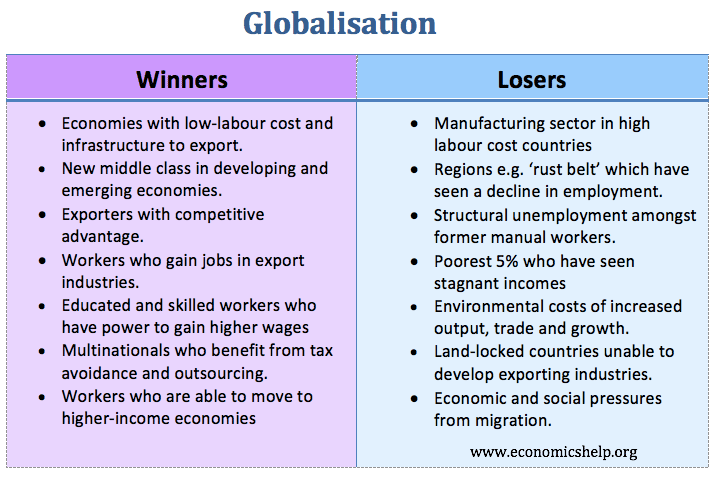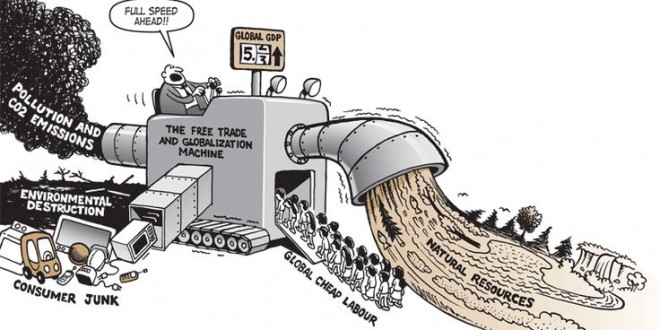When they could no longer roll over their debts, Latin American economies crashed, and a decade of stagnation resulted. But to turn the farm families’ malnutrition into starvation makes no sense. Instead, it could be spending money to bring farmers irrigation, technical help and credit. A system in which the government purchased farmers’ corn at a guaranteed price — done away with in states like Puebla during the free-market reforms of the mid-1990’s — has now been replaced by direct payments to farmers. The program is focused on the poor, but the payments are symbolic — $36 an acre. In addition, rural credit has disappeared, as the government has effectively shut down the rural bank, which was badly run, and other banks won’t lend to small farmers.
Countries are consuming more finite resources, such as oil, and many corporations cut costs by taking advantage of lax pollution laws in developing countries. This evolution of economic systems has increased industrialization and financial opportunities in many nations. Governments now focus on removing barriers to trade and promoting international commerce.
- In the rush to declare the end of globalization, it is important to remember that the theory of comparative advantage hasn’t gone away.
- Some economists argue globalization helps promote economic growth and increased trading between nations; yet, other experts, as well as the general public, generally see the negatives of globalization as outweighing the benefits.
- Countries that have liberalized their capital markets are especially susceptible, as short-term capital that has whooshed into a country on investor whim whooshes out just as fast when investors panic.
- Those who are dubious of the benefits of globalization point out that poverty has remained stubbornly high in sub-Saharan Africa.
- The “dismal science” truly shines in this optimistic talk, as economist Alex Tabarrok argues free trade and globalization are shaping our once-divided world into a community of idea-sharing more healthy, happy and prosperous than anyone’s predictions.
- In other words, connecting with people takes less time than ever before and moving from one space to another (e.g. around the world) is faster than ever before.
Volkswagen Mexico is the epitome of the strategy Mexico has chosen for globalization — assembly of imported parts. It is a strategy that makes perfect sense given Mexico’s proximity to the world’s largest market, and it has given rise to the maquila industry, which uses Mexican labor to assemble foreign parts and then re-export the finished products. Although the economic slowdown in the United States is hurting the maquila industry, it still employs a million people and brings the country $10 billion a year in foreign exchange. The factories have turned Mexico into one of the developing world’s biggest exporters of medium- and high-technology products.
Businesses have responded to each wave of globalisation problems by harnessing the technological developments presented to refine their strategy and increase growth. The next era will bring new innovation with artificial intelligence, which will present new opportunities to grow and the ongoing challenge of how to evolve and adapt. Don’t be fooled that a trading system with an unstable web of national controls will be more humane or safer. Poorer countries will find it harder to catch up and, in the rich world, life will be more expensive and less free. The way to make supply chains more resilient is not to domesticate them, which concentrates risk and forfeits economies of scale, but to diversify them.

This will certainly make globalization and its management more complex, but it is far better than trying to erect barriers in a vain attempt to stop irresistible, and potentially very beneficial, global forces. Globalization is a term that is used in many ways, but the principal underlying idea is the progressive integration of economies and societies. It is driven by new technologies, new economic relationships and the national and international policies of a wide range of actors, including governments, international organizations, business, labour and civil society. This can help developing nations increase overall employment but can be considered exploitation of nations with poor working conditions. Migration has accelerated along with the globalization of the economy and women comprise a higher proportion of migrants, especially labor migrants, and refugees than ever before. Feminist philosophical responses to the feminization of migration fall into three general lines of argument.
But the power of the idea has led to the overly credulous acceptance of much of what is put forward in its name. Stiglitz writes that there is simply no support for many I.M.F. policies, and in some cases the I.M.F. has ignored clear evidence that what it advocated was harmful. You can always argue — and American and I.M.F. officials do — that countries that follow the I.M.F.’s line but still fail to grow either didn’t follow the openness recipe precisely enough or didn’t check off other items on the to-do list, like expanding education. By opening its economy, a nation makes itself vulnerable to contagion from abroad.
Stiglitz believes the IMF and World Bank should be reformed, not dismantled—with a growing population, malaria and AIDS pandemics, and global environmental challenges, Keynes’ mandate for equitable growth is more urgent now than ever. He advocates a gradual, sequential, and selective approach to institutional development, land reform and privatization, capital market liberalization, competition policies, worker safety nets, health infrastructure, and education. Selective policies would direct funds to programs and governments which had success in the past. Lastly, democratic disciplines are needed to ensure that financial institutions serve general interests. More recent approaches to the feminization of global migration focus on what Arlie Hochschild refers to as “global care chains” These chains, which link women across the world, are established through the transnational exchange of domestic services. Global care chains typically begin when relatively well-off northern or Western women enter the paid labor force and hire other women, usually poorer women from developing countries, to care for their children and other dependents.
A report by the World Bank said that poverty in India and Indonesia was cut in half because of globalization. The report also said that people in poorer nations are living longer and better because they were making more money. Others, like Thomas Friedman, believe that globalization can bring people together and make everyone richer without getting rid of local cultures. People who support globalization also believe that it makes war less likely because it is bad for business. Francis Fukuyama also argued that globalization would eventually lead to a system of world governance which would cause wars to end.
In a state of panic, economists responded with a flood of columns and books that defended the necessity of a more open global market economy, in tones ranging from grandiose to sarcastic. In January 2000, Krugman used his first piece as a New York Times columnist to denounce the “trashing” of the WTO, calling it “a sad irony that the cause that has finally awakened the long-dormant American left is that of – yes! “We need to work with our supply chains and customers to solve these issues. I need to invest, increase automation and make our factories more welcoming for new recruits,” he said. Under the “Made in China” policy launched in 2018, China is already trying to develop more capacity in semiconductors, the lifeblood of consumer goods ranging from Teslas to toasters, and PlayStations to printers, as well as other strategic products.

Thirdly, they state that they should respect all cultures and support cross-cultural engagement. It gives rise to a disparity of resources and issues regarding waste management. If a single unit began to govern the entire world, it could lead to many negative consequences such as despotism. “Opening up borders poise a threat to national identity,” says most of the critics. For instance, a person may be from Iowa, but he will call himself an American first.


